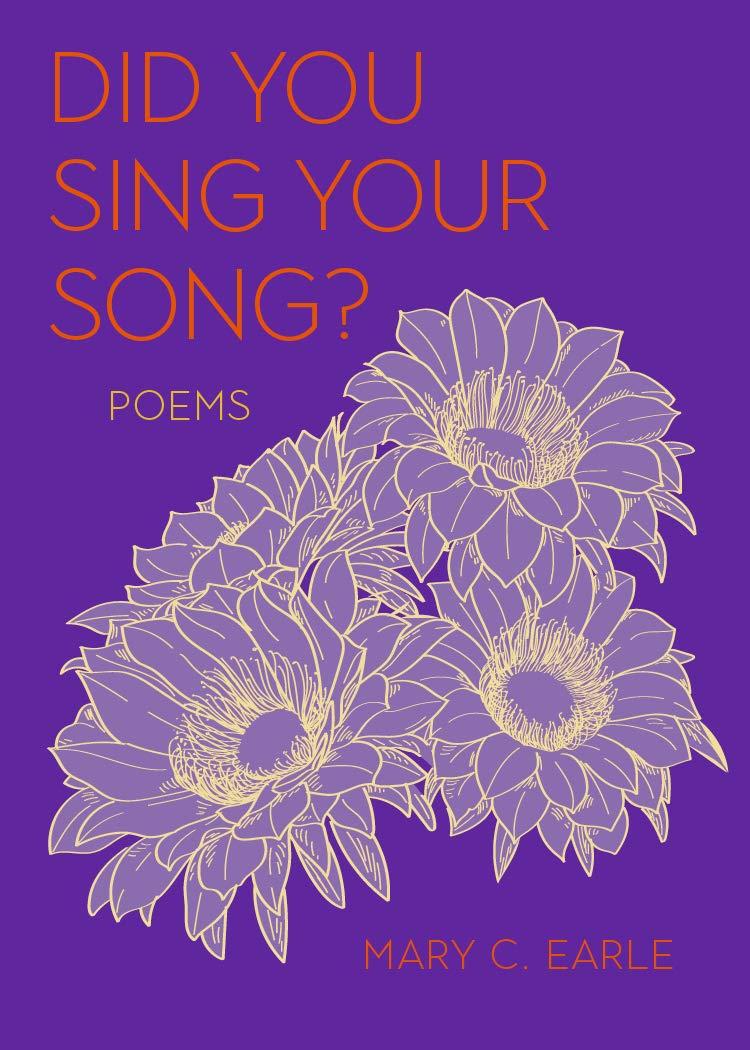
POETRY/CHRISTIANITY
Rev. Mary C. Earle
Material Media
Paperback, 978-1-9474-6007-2, 144 pgs., $17
January 12, 2020
During the long days of social distancing, I’ve appreciated Mary C. Earle’s Did You Sing Your Song? Every time I need a lift or a connection, I read a few of her poems. Even the cover, in royal purple with red letters and white flowers, calms and refocuses me.
An Episcopal priest and author of ten books, Mary Earle composed these poems over a twenty-year span. Although many have appeared elsewhere, Did You Sing Your Song? is her first poetry book. She uses repetition, rhythm, and anaphora in her work, which reflects her love of canticles and The Book of Common Prayer
Rev. Earle divides her book into four sections: Land, Voices from Scripture, Pilgrimages, and People. In the first section, she melds English and Spanish in the poem “Mi Tierra:”
I am not Mexican by blood
Yet this is mi tierra.
Esta tierra es mia,
Y yo soy de esta tierra.
I’ve grown roots here,
Roots so long and deep
That no amount of cedar-chopping
Will dislodge me from this soil.
Attuned to “a deeper song, a melody that could be perceived in wind and rain, in trees and flowers,” the author grew up in San Antonio, often visiting her grandparents in the Texas hill country outside of Boerne. There she sensed a hum, beyond the range of human hearing, that could be felt, “like the beat of a drum in the floor of a dancehall.” Earle’s poem “Obituary,” reveals her desire to return to “folds of hill country earth.”
I want the breeze that whistles down the creek bank
To gather up my ashes in its eternal song,
To gather and cast in one sweet movement,
Scattering those atoms that were briefly mine,
Into the soil as old as the hills.
In this song, with its lulling repetition of soft “s” sounds, the reader feels Earle’s oneness with the earth and the peace this brings to her.
Voices from Scripture, the second section, contains persona poems from the voices of biblical women like Mary, Hannah, Anna, Sarah, Dinah, and the Anointing Woman. Earle brings an undercurrent of contemporary life to these ancient stories. In “Luke 7:37-38, in Meditation 2,” the Anointing Woman, once a sinner, washes the feet of Jesus with her tears and dries them with her hair. Acknowledging the woman’s faith and kindness, Jesus says, “Do no harm to yourself.” When she realizes Jesus values her, she begins to respect herself. She says,
“By God,
There’s something,
Someone,
Here worth caring for,
Worth protecting,
Worth handling with respect.”
In “Annunciation,” a sassy Mary, not thrilled by the prospect of the physical discomfort of pregnancy, says she’ll bear a son for God, if the angel and God understand, “my carrying the baby meant they had to be pregnant too.”
Pilgrimages, the third part, reveals songs Rev. Earle considers as she travels. She asks,
Where are my mothers?
Where are all those women
Whose prayers have woven the delicate tatting,
The intricate lacework
That holds everything together?
After “an eternity of searching,” she finds them in the fading footnotes of mildewing manuscripts in convent vaults. “They clamor to be heard.” She visits Ireland and Wales, where elements like rocks, water, earth, and sky speak to Earle. “Listen,” she says. “The stones speak.” In them she witnesses the One who made everything.
When Rev. Earle writes about St. Mary’s Well in Wales, she uses anaphora, the repetition of the phrase “This water” at the beginning of each sentence which gives the words a rhythm, much like prayers or hymns.
In the last section of the book, Earle focuses on People. Her grandmother, Golda; a young friend with scarred wrists; a drunk kneeling in church; a dying woman with a rounded belly, “suggesting imminent delivery”; a Puerto Rican prophet; and even Emily Dickinson make appearances. The title poem comes in this section as the author remembers her son on the tenth anniversary of his death. Again, she uses anaphora to ask the reader. “Did you sing your song?” She releases her son, as another Mary once endured the loss of hers.
Rev. Earle reminds us to listen; songs are everywhere. In them and this gem of a book, we can find peace.
Mary Earle is an Episcopal priest, author, poet, retreat leader, and spiritual director. Until her retirement, she taught classes in spirituality for the Seminary of the Southwest in Austin, Texas. Earle has authored ten books; the subjects include the spirituality of living with illness, rule of life, Celtic Christian spirituality, the Desert Mothers, and Julian of Norwich. Her latest is a book of poetry. She has written articles for a variety of journals, including Presence: the Journal of Spiritual Directors International, Radical Grace, Reflections, and the Lutheran.
Earle has offered presentations and retreats in a variety of ecumenical settings, including conferences of the Academy for Spiritual Formation, Spiritual Directors International, the International Thomas Merton Society, Oblate School of Theology and hospice organizations. She was included in the Living Spiritual Teachers project of Spirituality and Practice.
Earle and her husband live in San Antonio with their border collie, Fiona, a cat named Leftovers, and lots of garden flora and fauna. Earle is also a knitter and weaver, so her office is full of skeins and balls of yarn. The Earles were numbered among the 2018 recipients of the Humanitarian Award from United Communities of San Antonio for their contributions to eliminating racism, prejudice, and bullying, and for their work to promote inclusiveness and diversity in the community.
